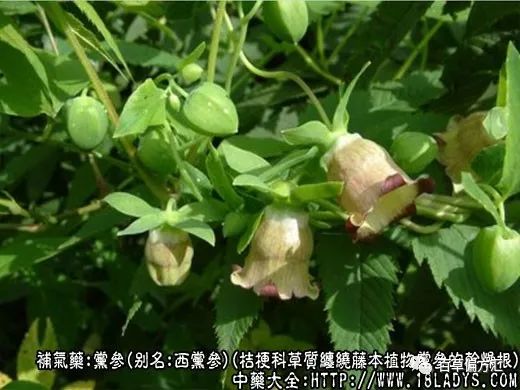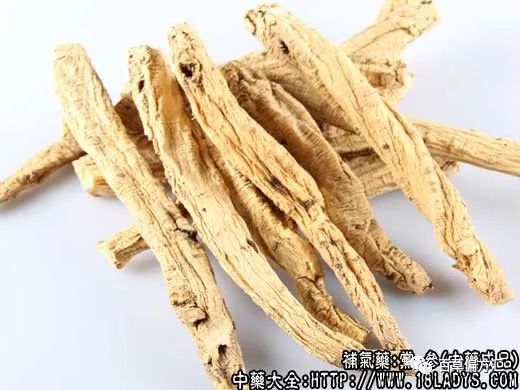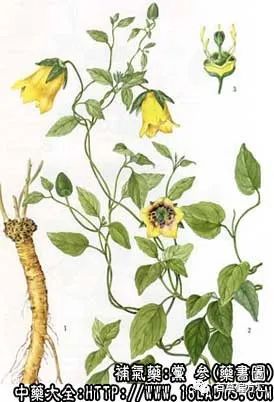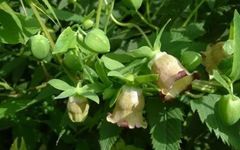


Codonopsis (党参, Dǎngshēn) is a commonly used traditional Chinese medicine. In ancient times, it was not distinguished from ginseng, with references suggesting that ginseng grows in the valleys of the Upper Party and Liaodong regions. Tao Hongjing stated: “The Upper Party is located in the southwest of Jizhou, and the current ones are long and yellow, resembling the shape of Fang Feng (防风, Saposhnikovia divaricata), with a sweet taste… The described shape and flavor are consistent with the current Codonopsis. It was not until the Qing Dynasty that the names Upper Party Ginseng and Fang Feng Codonopsis appeared in texts such as ‘Bencao Congxin’, ‘Bencao Fengyuan’, and ‘Gangmu Shiyi’.
Codonopsis is produced in many regions, with significant quality differences. Historically, its names were quite complex. Currently, based on the 54 types of medicinal material specifications issued by the Ministry of Commerce and the Ministry of Health, products from adjacent regions with similar quality are classified into five varieties: Western Codonopsis, Lu Codonopsis, Tiao Codonopsis, White Codonopsis, and Eastern Codonopsis. Products from each region are categorized according to their quality.
1. Western Codonopsis
Also known as: Wen Dang, Jing Dang, Tai Dang.
Source: The dried root of the perennial herbaceous climbing plant Codonopsis pilosula of the Campanulaceae family. Mostly wild.
Production area: Mainly produced in Gansu, Shaanxi, northern Sichuan, and Shanxi provinces.
Identification: The root is cylindrical, slightly curved, 10-50 cm long, and 0.5-2.5 cm in diameter, with a gray-brown or gray-yellow surface. The root’s head has numerous warty stem scars, commonly referred to as “Lion’s Head”, with each scar having a central depression. Older roots have more scars and a larger head. The lower part has dense ring-like transverse wrinkles, gradually becoming sparse downwards, with some reaching half the entire length. The lower part has longitudinal wrinkles, transverse pores, and root hair scars. A black, gelatinous substance is often seen at the broken root, formed by the internal juice oozing out and drying. The skin is loose, and the flesh is firm. The body is flexible, easily broken, with a yellow-white cross-section showing a chrysanthemum pattern. It has a unique aroma and a sweet taste, with no residue when chewed.
The best quality is characterized by a large, thick shape, many transverse wrinkles, loose skin, firm flesh, and a clear sweet taste.
2. Lu Codonopsis
Also known as: White Skin Codonopsis.
Source: Same as Western Codonopsis. Both are cultivated.
Production area: Mainly produced in Ping Shun, Ling Chuan, Hu Guan, Chang Zhi, Li Cheng, Wu Xiang in Shanxi, and Anyang in Henan.
Identification: The root is cylindrical, mostly unbranched, 10-30 cm long, and 0.3-1 cm in diameter (those with longer cultivation years and a diameter over 1 cm are commonly referred to as “Yi Tiao Dang”, with better quality). The surface is light gray-yellow. The “Lion’s Head” is smaller, with sparse transverse wrinkles near the root head, and the entire root has deep, irregular longitudinal wrinkles and transverse pores, with a fine and tight skin. The body is firm yet soft. The cross-section is light yellow or yellow-white, with a tighter cortex and a yellow round center. It has a faint aroma and a sweet taste.
The best quality is characterized by a single root without branching, plump and thick, with a yellow-white cross-section.
3. Eastern Codonopsis
Also known as: Jilin Codonopsis.
Source: Same as Western Codonopsis. Cultivated and wild.
Production area: Mainly produced in Jilin, Liaoning, and Heilongjiang.
Identification: The product is cylindrical, about 30 cm long, and 0.7-1.5 cm in diameter. The surface is yellow-white to gray-brown, rough, with a lion’s head, transverse wrinkles at the upper end, and longitudinal wrinkles at the lower end, with raised skin pores. The body is loose and hard, easily broken, with a light yellow-white cross-section showing cracks and a light yellow center. It has a slight odor and a mildly sweet taste, with residue when chewed.
The best quality has thick, uniform root strips with a sweet taste.
4. Tiao Codonopsis
Also known as: Single Branch Codonopsis, Eight Immortals Codonopsis.
Source: The dried root of the perennial herbaceous climbing plant Codonopsis lanceolata of the Campanulaceae family. Mostly wild.
Production area: Mainly produced in Sichuan, Hubei, and Shaanxi provinces.
Identification: The root is long and cylindrical (mostly strip-shaped, hence the name Tiao Codonopsis), relatively thick, twisted or straight. It is 20-50 cm long and 0.7-2 cm in diameter. The surface is yellow-white or brownish, with a finer skin. Larger roots have a “Lion’s Head”, but the stem scars are fewer and smaller, with the fine branches smaller than the main body, referred to as “Mud Eel Head”. The upper end is slightly square, with or without transverse wrinkles, and the lower end has longitudinal wrinkles. The body is soft and moist, with a light yellow cross-section showing radial patterns and a yellow center. It has a faint aroma and a sweet taste.
The best quality has thick root strips, fine skin, sufficient sugar content, and a sweet taste with no residue when chewed.
5. White Codonopsis
Also known as: Xu Fu Shen (originally concentrated in Sichuan Xu Fu, now referred to as Yibin), Guizhou Codonopsis (now mostly exported from Guizhou).
Source: The dried root of the perennial herbaceous climbing plant Codonopsis pilosula of the Campanulaceae family. All wild.
Production area: Mainly produced in Guizhou, Yunnan, and southwestern Sichuan.
Identification: The root is cylindrical, slightly curved, varying in size, 5-20 cm long, and 0.5-1 cm in diameter. The surface is yellow-white and relatively smooth. It has “Lion’s Head” and indistinct transverse wrinkles, with many longitudinal wrinkles and point-like root hair scars. The texture is hard and easily broken. The cross-section is yellow-white, with a light yellow heart. It has a faint aroma and a mildly sweet and slightly sour taste, with residue when chewed.
Among these five types of Codonopsis, the Western Codonopsis (wild) is the best, followed by Tiao Codonopsis, Lu Codonopsis, Eastern Codonopsis, and White Codonopsis being the least.
Main components: Contains alkaloids, saponins, proteins, starch, vitamin B1, vitamin B2, etc.
Pharmacological effects:
1. Tonifies the middle and benefits qi, harmonizes the spleen and stomach: It has a strengthening and appetite-enhancing effect, can promote metabolism, aid digestion, and enhance chyle absorption.
2. Nourishes blood: It can increase red blood cells and hemoglobin in rabbits, and its blood-nourishing effect may stem from Codonopsis itself and its interaction with certain components in the spleen.
3. Lowers blood pressure: Animal experiments have shown that it lowers blood pressure by dilating peripheral blood vessels and inhibiting adrenaline.
4. Resolves phlegm and suppresses cough.
Preparation: Cut and chew, used raw.
Properties: Sweet, neutral.
Meridians: Enters the spleen and lung meridians.
Functions: Tonifies the middle, benefits qi, generates fluids.
Indications: Spleen and stomach deficiency, insufficient lung qi, fluid damage leading to thirst.
Clinical applications:
1. Used for weakness caused by various reasons, especially for spleen and stomach deficiency, low digestive absorption function, middle qi descent, and spontaneous sweating, often combined with Bai Zhu (白术, Atractylodes macrocephala), Fu Ling (茯苓, Poria cocos), Huaishan (淮山药, Dioscorea opposita), and Lian Zi Rou (莲子肉, Lotus seed), in formulas such as Shen Ling Bai Zhu San (参苓白术散) and Si Jun Zi Tang (四君子汤). The Si Jun Zi Tang is a fundamental formula for treating spleen and stomach deficiency, and any condition caused by spleen deficiency can be treated by modifying this qi-tonifying formula.
2. Used for iron deficiency anemia and malnutrition anemia, especially anemia caused by spleen and stomach deficiency and digestive absorption dysfunction, as well as for conditions like atrophic gastritis, often combined with Ji Xue Teng (鸡血藤, Millettia dielsiana), Dang Gui (当归, Angelica sinensis), Bai Shao (白芍, Paeonia lactiflora), and Shu Di Huang (熟地, Rehmannia glutinosa), in formulas such as Blood Nourishing Decoction (补血汤). Clinical experience shows that Codonopsis has a good blood-nourishing effect.
3. Used for chronic cough with lung deficiency symptoms, especially effective for mild toxic symptoms of pulmonary tuberculosis, taking advantage of its phlegm-resolving, cough-suppressing, and qi-tonifying effects, often combined with Zi Wan (紫菀, Aster tataricus), Wu Wei Zi (五味子, Schisandra chinensis), and Ejiao (阿胶, Donkey-hide gelatin).
Additionally, Codonopsis can be used for nephritis, reducing urinary protein excretion.
Note: Codonopsis and ginseng have similar properties, so in general tonifying formulas that use ginseng can be substituted with Codonopsis. It is particularly suitable for Si Jun Zi Tang (四君子汤), Li Jun Zi Tang (六君子汤), and Gui Pi Tang (归脾汤). However, since Codonopsis is less potent than ginseng, the dosage should be increased (2-3 times that of ginseng); also, due to its weaker ability to tonify the original qi and its blood pressure-lowering effect, it is still advisable to use ginseng for critical conditions of yang qi deficiency (cardiovascular failure).
Usage precautions: Do not combine with Li Lu (藜芦); use cautiously in cases of qi stagnation and inflammation; sometimes, to prevent qi stagnation, Chen Pi (陈皮, Dried tangerine peel) or Sha Ren (砂仁, Amomum villosum) can be added.
Dosage: 12-30 g. For single use, it can be up to 90-120 g.
Example prescriptions:
Si Jun Zi Tang (四君子汤) (from ‘Jufang’): Codonopsis 12 g, Bai Zhu 12 g, Fu Ling 12 g, roasted licorice 6 g, decoct in water for oral administration.
Blood Nourishing Decoction: Codonopsis 12 g, Ji Xue Teng 30 g, Dang Gui 15 g, Bai Shao 9 g, Shu Di 18 g, decoct in water for oral administration.
Note:
1. Codonopsis was historically produced in Changzhi, Shanxi, named after the Upper Party County during the Qin Dynasty, and later renamed Lu Prefecture during the Sui Dynasty, hence the name Lu Codonopsis.
2. In addition to the varieties mentioned in the text, other known sources and products include the following varieties.
① Big Head Codonopsis: From the Campanulaceae family, produced in parts of Ganzi Prefecture, Liangshan Prefecture, and Xichang in Sichuan. Generally about 20 cm long and 1.5 cm in diameter. Brownish-yellow and earthy yellow, with a particularly large “Lion’s Head”, small tail, few ring patterns, and a dry, hard texture like wood. It has a mildly sweet taste and is very fibrous when chewed.
② Ganzi Codonopsis: From the Campanulaceae family, produced in northern Ganzi Prefecture (woody) and southern Ganzi (herbaceous) and in areas like Yanyuan and Muli. The root is cylindrical or flat-cylindrical, mostly single-stemmed, generally about 15 cm long and 2 cm in diameter, with some reaching 3-4 cm. The surface is earthy brown, with a small pointed root head, and some woody stems protruding, resembling a “snake head”, with irregular transverse and longitudinal wrinkles. The texture is hard, slightly flexible, and not easily broken, with a yellow-white cross-section, thick skin, and a large, solid yellow heart, slightly patterned. It has a faint aroma, slightly sweet taste, and is fibrous when chewed.
③ Xinjiang Codonopsis: From the root of the Xinjiang Codonopsis plant of the Campanulaceae family, mainly produced in Xinjiang. The root strips are slightly cylindrical, 14-60 cm long, and 0.8-3 cm in diameter. The surface is light yellow-white, and the main feature is that it does not have a “Lion’s Head” shape, with a thin, slender head, a bulging middle, and a gradually tapering tail. The upper part of the root has dense and deep ring patterns, and the surface does not ooze juice. The cross-section is milky white and loose, with many cracks, resembling a honeycomb.
④ Sheep Milk (known as White Python Meat in Northeast China): From the root of the four-leaf ginseng (奶参, Asparagus cochinchinensis) of the Campanulaceae family. Distributed in Northeast, North, East, and Central South provinces. The root is conical and spindle-shaped, robust, with stem scars at the top. The surface is light yellow-brown and rough, with transverse wrinkles and small warty protrusions. The texture is very loose, with a light red cross-section, no yellow heart, many cracks, and a honeycomb appearance. It has a faint aroma and a mildly sweet and slightly bitter taste. In some regions, it is used as Codonopsis, while in most areas, it is used as a lactation and tonifying herb.
These four types of Codonopsis are not included in the standards issued by the two ministries and are sold according to local customs. Among them, Ganzi Codonopsis has caused poisoning incidents in Hainan Island and Jiangsu due to contamination with Li Lu and Wolf Poison, and local attention has been raised to process and remove them.
In recent years, there are also square Codonopsis produced in Yunnan. The roots are square, with ridges and spines, and a hard texture; small root strips of Codonopsis produced in Guizhou and Yunnan. The root strips are small, resembling “Xuduan” (续断). They are thin, curved, with a yellow-brown rough skin, longitudinal wrinkles, and some slightly resembling “Lion’s Head”, with a gray-yellow or dry yellow cross-section. The taste is mild, slightly bitter, or bitter. (The original plant family of these two types is still unknown).
Currently, most cultivated Codonopsis is derived from the Lu Codonopsis lineage, and the product forms vary due to differences in climate and soil, with some variations, such as products from Baoding, which grow quickly, have small roots, thick bodies, fine skin, few wrinkles, and sufficient sugar content…
Note: Ming Codonopsis is a commonly used traditional Chinese medicine. It is not recorded in the herbal texts.
Source: The dried root of the perennial herbaceous plant Ming Codonopsis of the Apiaceae family. Wild or cultivated.
Production area: Mainly produced in Anhui, Jiangsu, Zhejiang, Sichuan, Hubei, and other regions.
Harvesting and processing: The roots are dug in spring, cleaned of soil, sorted by size, boiled in boiling water until thoroughly cooked, removed, peeled, and dried.
Identification: The root is slender and cylindrical or spindle-shaped, about 9-20 cm long and 0.6-2 cm in diameter. The surface is light yellow-white or light brown, slightly translucent, with longitudinal grooves and fine straight lines, and a few root hair scars. The texture is hard, with a cross-section that is semi-transparent light brown, horn-like, easily peeled, with a large light yellow-white woody heart in the center. It has a faint aroma and a mild taste.
The best quality is characterized by slender, uniform strips, solid and heavy texture, yellow-white surface, and semi-translucent appearance, with a light yellow cross-section.
Preparation: Sliced, used raw.
Properties: Sweet, slightly bitter, slightly cold.
Meridians: Enters the lung and stomach meridians.
Functions: Benefits the lungs, resolves phlegm, harmonizes the stomach, stops vomiting, detoxifies.
Indications: Cough, hiccups, and detoxification.
Note: In Jiangsu, it is not boiled, peeled, and dried, while in Zhejiang, those cut longitudinally in half and dried are called “Fen Sha Shen”, which has a similar property to Ming Codonopsis, with a white cross-section, powdery texture, faint fragrance, and sweet taste. Its effects are the same as Ming Codonopsis.
More Exciting Recommendations:
Traditional Chinese Medicine: The Efficacy of Perilla
Traditional Chinese Medicine: The Efficacy of Artemisia
Traditional Chinese Medicine: The Efficacy and Functions of Pinellia
Traditional Chinese Medicine: The Efficacy and Functions of Hedyotis (6 Major Functions and Consumption Methods)
The above contentis sourced from the internet,for reference only,please delete if infringing!
Follow the doctor’s advice! Do not self-medicate! Be the first to collect and share with friends,the more people see it, the more health benefits!
Be the first to collect and share with friends,the more people see it, the more health benefits!

